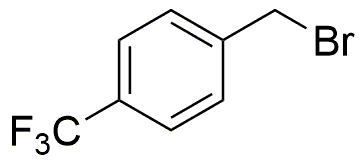4-(Trifluoromethyl)benzyl bromide is widely utilized in research focused on:
- Synthesis of Pharmaceuticals: This compound serves as a versatile building block in the synthesis of various pharmaceutical agents, particularly those targeting neurological disorders due to its unique trifluoromethyl group, which enhances biological activity.
- Fluorinated Compounds Development: It plays a crucial role in the development of fluorinated organic compounds, which are essential in agrochemicals and specialty chemicals, providing improved efficacy and stability compared to non-fluorinated alternatives.
- Material Science: The compound is utilized in the creation of advanced materials, including polymers and coatings, where its properties contribute to enhanced durability and resistance to environmental factors.
- Organic Synthesis: It is employed in various organic synthesis reactions, acting as a reactive intermediate that facilitates the formation of complex organic molecules, which is valuable in both academic and industrial research settings.
- Analytical Chemistry: This chemical is also used in analytical applications, helping researchers in the development of new methods for detecting and quantifying substances in complex mixtures, thereby improving accuracy and reliability in results.
General Information
Properties
Safety and Regulations
Applications
4-(Trifluoromethyl)benzyl bromide is widely utilized in research focused on:
- Synthesis of Pharmaceuticals: This compound serves as a versatile building block in the synthesis of various pharmaceutical agents, particularly those targeting neurological disorders due to its unique trifluoromethyl group, which enhances biological activity.
- Fluorinated Compounds Development: It plays a crucial role in the development of fluorinated organic compounds, which are essential in agrochemicals and specialty chemicals, providing improved efficacy and stability compared to non-fluorinated alternatives.
- Material Science: The compound is utilized in the creation of advanced materials, including polymers and coatings, where its properties contribute to enhanced durability and resistance to environmental factors.
- Organic Synthesis: It is employed in various organic synthesis reactions, acting as a reactive intermediate that facilitates the formation of complex organic molecules, which is valuable in both academic and industrial research settings.
- Analytical Chemistry: This chemical is also used in analytical applications, helping researchers in the development of new methods for detecting and quantifying substances in complex mixtures, thereby improving accuracy and reliability in results.
Documents
Safety Data Sheets (SDS)
The SDS provides comprehensive safety information on handling, storage, and disposal of the product.
Product Specification (PS)
The PS provides a comprehensive breakdown of the product’s properties, including chemical composition, physical state, purity, and storage requirements. It also details acceptable quality ranges and the product's intended applications.
Certificates of Analysis (COA)
Search for Certificates of Analysis (COA) by entering the products Lot Number. Lot and Batch Numbers can be found on a product’s label following the words ‘Lot’ or ‘Batch’.
Numéro de catalogue
Numéro de lot/série
Certificates Of Origin (COO)
This COO confirms the country where the product was manufactured, and also details the materials and components used in it and whether it is derived from natural, synthetic, or other specific sources. This certificate may be required for customs, trade, and regulatory compliance.
Numéro de catalogue
Numéro de lot/série
Safety Data Sheets (SDS)
The SDS provides comprehensive safety information on handling, storage, and disposal of the product.
DownloadProduct Specification (PS)
The PS provides a comprehensive breakdown of the product’s properties, including chemical composition, physical state, purity, and storage requirements. It also details acceptable quality ranges and the product's intended applications.
DownloadCertificates of Analysis (COA)
Search for Certificates of Analysis (COA) by entering the products Lot Number. Lot and Batch Numbers can be found on a product’s label following the words ‘Lot’ or ‘Batch’.
Numéro de catalogue
Numéro de lot/série
Certificates Of Origin (COO)
This COO confirms the country where the product was manufactured, and also details the materials and components used in it and whether it is derived from natural, synthetic, or other specific sources. This certificate may be required for customs, trade, and regulatory compliance.


